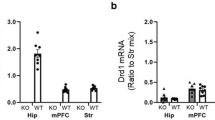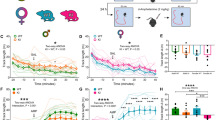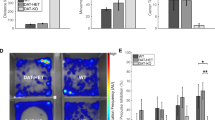Abstract
MDMA or ‘ecstasy’ (3,4-methylenedioxymethamphetamine) is a commonly used psychoactive drug that has unusual and distinctive behavioral effects in both humans and animals. In rodents, MDMA administration produces a unique locomotor activity pattern, with high activity characterized by smooth locomotor paths and perseverative thigmotaxis. Although considerable evidence supports a major role for serotonin release in MDMA-induced locomotor activity, dopamine (DA) receptor antagonists have recently been shown to attenuate these effects. Here, we tested the hypothesis that DA D1, D2, and D3 receptors contribute to MDMA-induced alterations in locomotor activity and motor patterns. DA D1, D2, or D3 receptor knockout (KO) and wild-type (WT) mice received vehicle or (+/−)-MDMA and were tested for 60 min in the behavioral pattern monitor (BPM). D1 KO mice exhibited significant increases in MDMA-induced hyperactivity in the late testing phase as well as an overall increase in straight path movements. In contrast, D2 KO mice exhibited reductions in MDMA-induced hyperactivity in the late testing phase, and exhibited significantly less sensitivity to MDMA-induced perseverative thigmotaxis. At baseline, D2 KO mice also exhibited reduced activity and more circumscribed movements compared to WT mice. Female D3 KO mice showed a slight reduction in MDMA-induced hyperactivity. These results confirm differential modulatory roles for D1 and D2 and perhaps D3 receptors in MDMA-induced hyperactivity. More specifically, D1 receptor activation appears to modify the type of activity (linear vs circumscribed), whereas D2 receptor activation appears to contribute to the repetitive circling behavior produced by MDMA.
Similar content being viewed by others
Log in or create a free account to read this content
Gain free access to this article, as well as selected content from this journal and more on nature.com
or
References
Accili D, Fishburn CS, Drago J, Steiner H, Lachowicz JE, Park BH et al (1996). A targeted mutation of the D3 dopamine receptor gene is associated with hyperactivity in mice. Proc Natl Acad Sci USA 93: 1945–1949.
Adams LM, Geyer MA (1982). LSD-induced alterations of locomotor patterns and exploration in rats. Psychopharmacology (Berlin) 77: 179–185.
Ariano MA, Drago J, Sibley DR, Levine MS (1998). Striatal excitatory amino acid receptor subunit expression in the D1A-dopamine receptor-deficient mouse. Dev Neurosci 20: 237–241.
Baik J-H, Picetti R, Saiardi A, Thiriet G, Dierich A, Depaulis A et al (1995). Parkinsonian-like locomotor impairment in mice lacking dopamine D2 receptors. Nature 377: 424.
Ball KT, Budreau D, Rebec GV (2003). Acute effects of 3,4-methylenedioxymethamphetamine on striatal single-unit activity and behavior in freely moving rats: differential involvement of dopamine D(1) and D(2) receptors. Brain Res 994: 203–215.
Bankson MG, Cunningham KA (2001). 3,4-Methylenedioxymethamphetamine (MDMA) as a unique model of serotonin receptor function and serotonin–dopamine interactions. J Pharmacol Exp Ther 297: 846–852.
Bankson MG, Cunningham KA (2002). Pharmacological studies of the acute effects of (+)-3,4-methylenedioxymethamphetamine on locomotor activity: role of 5-HT(1B/1D) and 5-HT(2) receptors. Neuropsychopharmacology 26: 40–52.
Bengel D, Murphy DL, Andrews AM, Wichems CH, Feltner D, Heils A et al (1998). Altered brain serotonin homeostasis and locomotor insensitivity to 3, 4-methylenedioxymethamphetamine (‘Ecstasy’) in serotonin transporter-deficient mice. Mol Pharmacol 53: 649–655.
Bubar MJ, Pack KM, Frankel PS, Cunningham KA (2004). Effects of dopamine D1- or D2-like receptor antagonists on the hypermotive and discriminative stimulus effects of (+)-MDMA. Psychopharmacology (Berlin) 173: 326–336.
Callaway CW, Johnson MP, Gold LH, Nichols DE, Geyer MA (1991). Amphetamine derivatives induce locomotor hyperactivity by acting as indirect serotonin agonists. Psychopharmacology (Berlin) 104: 293–301.
Callaway CW, Rempel N, Peng RY, Geyer MA (1992). Serotonin 5-HT1-like receptors mediate hyperactivity in rats induced by 3,4-methylenedioxymethamphetamine. Neuropsychopharmacology 7: 113–127.
Callaway CW, Wing LL, Geyer MA (1990). Serotonin release contributes to the locomotor stimulant effects of 3,4-methylenedioxymethamphetamine in rats. J Pharmacol Exp Ther 254: 456–464.
Centonze D, Grande C, Saulle E, Martin AB, Gubellini P, Pavon N et al (2003). Distinct roles of D1 and D5 dopamine receptors in motor activity and striatal synaptic plasticity. J Neurosci 23: 8506–8512.
Chartoff EH, Marck BT, Matsumoto AM, Dorsa DM, Palmiter RD (2001). Induction of stereotypy in dopamine-deficient mice requires striatal D1 receptor activation. Proc Natl Acad Sci USA 98: 10451–10456.
Crawley JN, Belknap JK, Collins A, Crabbe JC, Frankel W, Henderson N et al (1997). Behavioral phenotypes of inbred mouse strains: implications and recommendations for molecular studies. Psychopharmacology (Berlin) 132: 107–124.
Creese I (1983). Stimulants: Neurochemical, Behavioral, and Clinical Perspectives. Raven Press: New York, NY.
Crespi D, Mennini T, Gobbi M (1997). Carrier-dependent and Ca(2+)-dependent 5-HT and dopamine release induced by (+)-amphetamine, 3,4-methylendioxymethamphetamine, p-chloroamphetamine and (+)-fenfluramine. Br J Pharmacol 121: 1735–1743.
Daly SA, Waddington JL (1992). New classes of selective D-1 dopamine receptor antagonist provide further evidence for two directions of D-1:D-2 interaction. Neurochem Int 20 (Suppl): 135S–139S.
Daly SA, Waddington JL (1993). Behavioural effects of the putative D-3 dopamine receptor agonist 7-OH-DPAT in relation to other ‘D-2-like’ agonists. Neuropharmacology 32: 509–510.
Drago J, Gerfen CR, Lachowicz JE, Steiner H, Hollon TR, Love PE et al (1994). Altered striatal function in a mutant mouse lacking D1A dopamine receptors. Proc Natl Acad Sci USA 91: 12564–12568.
Eilam D, Golani I, Szechtman H (1989). D2-agonist quinpirole induces perseveration of routes and hyperactivity but no perseveration of movements. Brain Res 490: 255–267.
Elliot EE, Sibley DR, Katz JL (2003). Locomotor and discriminative-stimulus effects of cocaine in dopamine D5 receptor knockout mice. Psychopharmacology 169: 161.
Fantegrossi WE, Kiessel CL, De la Garza II R, Woods JH (2005). Serotonin synthesis inhibition reveals distinct mechanisms of action for MDMA and its enantiomers in the mouse. Psychopharmacology (Berlin) 181: 529–536.
Fetsko LA, Xu R, Wang Y (2003). Alterations in D1/D2 synergism may account for enhanced stereotypy and reduced climbing in mice lacking dopamine D2L receptor. Brain Res 967: 191–200.
Fink H, Morgenstern R (1985). Locomotor effects of lisuride: a consequence of dopaminergic and serotonergic actions. Psychopharmacology (Berlin) 85: 464–468.
Fletcher PJ, Korth KM, Robinson SR, Baker GB (2002). Multiple 5-HT receptors are involved in the effects of acute MDMA treatment: studies on locomotor activity and responding for conditioned reinforcement. Psychopharmacology (Berlin) 162: 282–291.
Geyer MA (1990). Approaches to the characterization of drug effects on locomotor activity in rodents. In: Adler MS, Cowan A (eds). Testing and Evaluation of Drugs of Abuse. Alan R. Liss: New York, NY. pp 81–99.
Geyer MA, Russo PV, Masten VL (1986). Multivariate assessment of locomotor behavior: pharmacological and behavioral analyses. Pharmacol Biochem Behav 25: 277–288.
Geyer MA, Segal DS (1991). Behavioral psychopharmacology. In: Judd LL and Groves PM (eds). Psychobiological Foundations of Clinical Psychiatry, Chapter 45. JB Lippincott Co.: Philadelphia. pp 1–15.
Gold LH, Geyer MA, Koob GF (1989). Neurochemical mechanisms involved in behavioral effects of amphetamines and related designer drugs. NIDA Res Monogr 94: 101–126.
Gold LH, Koob GF, Geyer MA (1988). Stimulant and hallucinogenic behavioral profiles of 3,4-methylenedioxymethamphetamine and N-ethyl-3,4-methylenedioxyamphetamine in rats. J Pharmacol Exp Ther 247: 547–555.
Harrod SB, Mactutus CF, Bennett K, Hasselrot U, Wu G, Welch M et al (2004). Sex differences and repeated intravenous nicotine: behavioral sensitization and dopamine receptors. Pharmacol Biochem Behav 78: 581.
Jaber M, Robinson SW, Missale C, Caron MG (1996). Dopamine receptors and brain function. Neuropharmacology 35: 1503–1519.
Joseph JD, Wang YM, Miles PR, Budygin EA, Picetti R, Gainetdinov RR et al (2002). Dopamine autoreceptor regulation of release and uptake in mouse brain slices in the absence of D3 receptors. Neuroscience 112: 39.
Kehne JH, Ketteler HJ, McCloskey TC, Sullivan CK, Dudley MW, Schmidt CJ (1996). Effects of the selective 5-HT2A receptor antagonist MDL 100907 on MDMA-induced locomotor stimulation in rats. Neuropsychopharmacology 15: 116–124.
Kelly MA, Rubinstein M, Phillips TJ, Lessov CN, Burkhart-Kasch S, Zhang G et al (1998). Locomotor activity in D2 dopamine receptor-deficient mice is determined by gene dosage, genetic background, and developmental adaptations. J Neurosci 18: 3470.
Kelly PH, Iversen SD (1976). Selective 6OHDA-induced destruction of mesolimbic dopamine neurons: abolition of psychostimulant-induced locomotor activity in rats. Eur J Pharmacol 40: 45–56.
Koch S, Galloway MP (1997). MDMA induced dopamine release in vivo: role of endogenous serotonin. J Neural Transm 104: 135–146.
Koeltzow TE, Xu M, Cooper DC, Hu XT, Tonegawa S, Wolf ME et al (1998). Alterations in dopamine release but not dopamine autoreceptor function in dopamine D3 receptor mutant mice. J Neurosci 18: 2231.
Krebs KM, Geyer MA (1993). Behavioral characterization of alpha-ethyltryptamine, a tryptamine derivative with MDMA-like properties in rats. Psychopharmacology (Berlin) 113: 284–287.
Lat J (1965). The spontaneous exploratory reactions as a tool for psychopharmacological studies. A contribution towards a theory of contradictory results in psychopharmacology. In: Mikhelson MY, Longo VG, Votava Z (eds). Pharmacology of Conditioning, Learning and Retention. Pergamon Press: Oxford. pp 47–66.
Lawler CP, Prioleau C, Lewis MM, Mak C, Jiang D, Schetz JA et al (1999). Interactions of the novel antipsychotic aripiprazole (OPC-14597) with dopamine and serotonin receptor subtypes. Neuropsychopharmacology 20: 612–627.
Le Foll B, Diaz J, Sokoloff P (2005). Neuroadaptations to hyperdopaminergia in dopamine D3 receptor-deficient mice. Life Sci 76: 1281.
Lehmann-Masten VD, Geyer MA (1991). Spatial and temporal patterning distinguishes the locomotor activating effects of dizocilpine and phencyclidine in rats. Neuropharmacology 30: 629–636.
Martinez-Price DL, Krebs-Thomson K, Geyer MA (2002). Behavioral psychopharmacology of MDMA and MDMA-like drugs: a review of human and animal studies. Addict Res Theory 10: 43–67.
Millan MJ, Newman-Tancredi A, Quentric Y, Cussac D (2001). The ‘selective’ dopamine D1 receptor antagonist, SCH23390, is a potent and high efficacy agonist at cloned human serotonin2C receptors. Psychopharmacology (Berlin) 156: 58–62.
Mizuo K, Narita M, Miyatake M, Suzuki T (2004). Enhancement of dopamine-induced signaling responses in the forebrain of mice lacking dopamine D3 receptor. Neurosci Lett 358: 13.
Nichols DE, Hoffman AJ, Oberlender RA, Jacob III P, Shulgin AT (1986). Derivatives of 1-(1,3-benzodioxol-5-yl)-2-butanamine: representatives of a novel therapeutic class. J Med Chem 29: 2009–2015.
Paulus MP, Geyer MA (1991). A temporal and spatial scaling hypothesis for the behavioral effects of psychostimulants. Psychopharmacology (Berlin) 104: 6–16.
Paulus MP, Geyer MA (1992). The effects of MDMA and other methylenedioxy-substituted phenylalkylamines on the structure of rat locomotor activity. Neuropsychopharmacology 7: 15–31.
Paulus MP, Geyer MA (1997). Environment and unconditioned motor behavior: influences of drugs and environmental geometry on behavioral organization in rats. Psychobiology 25: 327–337.
Phillips TJ, Brown KJ, Burkhart-Kasch S, Wenger CD, Kelly MA, Rubinstein M et al (1998). Alcohol preference and sensitivity are markedly reduced in mice lacking dopamine D2 receptors. Nat Neurosci 1: 610.
Powell SB, Lehmann-Masten VD, Paulus MP, Gainetdinov RR, Caron MG, Geyer MA (2004). MDMA ‘ecstasy’ alters hyperactive and perseverative behaviors in dopamine transporter knockout mice. Psychopharmacology (Berlin) 173: 310–317.
Ralph RJ, Paulus MP, Fumagalli F, Caron MG, Geyer MA (2001). Prepulse inhibition deficits and perseverative motor patterns in dopamine transporter knock-out mice: differential effects of D1 and D2 receptor antagonists. J Neurosci 21: 305–313.
Ralph-Williams RJ, Lehmann-Masten V, Otero-Corchon V, Low MJ, Geyer MA (2002). Differential effects of direct and indirect dopamine agonists on prepulse inhibition: a study in D1 and D2 receptor knock-out mice. J Neurosci 22: 9604–9611.
Scearce-Levie K, Viswanathan SS, Hen R (1999). Locomotor response to MDMA is attenuated in knockout mice lacking the 5-HT1B receptor. Psychopharmacology (Berlin) 141: 154–161.
Schiorring E (1979). An open field study of stereotyped locomotor activity in amphetamine-treated rats. Psychopharmacology (Berlin) 66: 281–287.
Schmidt CJ (1987). Neurotoxicity of the psychedelic amphetamine, methylenedioxymethamphetamine. J Pharmacol Exp Ther 240: 1–7.
Segal DS (1975). Behavioral characterization of d- and l-amphetamine: neurochemical implications. Science 190: 475–477.
Segal DS, Geyer MA (1985). Animal models of psychopathology. In: Groves LLJaPM (ed). Psychobiological Foundations of Clinical Psychiatry, Chapter 46. JB Lippincott Co.: Philadelphia. pp 1–21.
Segal DS, Geyer MA, Schuckit MA (1981). Stimulant-induced psychosis: an evaluation of animal methods. Essays Neurochem Neuropharmacol 5: 95–129.
Segal DS, Geyer MA, Weiner BE (1975). Strain differences during intraventricular infusion of norepinephrine: possible role of receptor sensitivity. Science 189: 301–303.
Segal DS, Kuczenski R (1987). Individual differences in responsiveness to single and repeated amphetamine administration: behavioral characteristics and neurochemical correlates. J Pharmacol Exp Ther 242: 917–926.
Segal DS, Mandell AJ (1970). Behavioral activation of rats during intraventricular infusion of norepinephrine. Proc Natl Acad Sci USA 66: 289–293.
Segal DS, Sullivan III JL, Kuczenski RT, Mandell AJ (1971). Effects of long-term reserpine treatment on brain tyrosine hydroxylase and behavioral activity. Science 173: 847–849.
Segal DS, Weinberger SB, Cahill J, McCunney SJ (1980). Multiple daily amphetamine administration: behavioral and neurochemical alterations. Science 207: 905–907.
Steele TD, Nichols DE, Yim GK (1987). Stereochemical effects of 3,4-methylenedioxymethamphetamine (MDMA) and related amphetamine derivatives on inhibition of uptake of [3H]monoamines into synaptosomes from different regions of rat brain. Biochem Pharmacol 36: 2297–2303.
Stinus L, Koob GF, Ling N, Bloom FE, Le Moal M (1980). Locomotor activation induced by infusion of endorphins into the ventral tegmental area: evidence for opiate–dopamine interactions. Proc Natl Acad Sci USA 77: 2323–2327.
Svensson K, Carlsson A, Waters N (1994). Locomotor inhibition by the D3 ligand R-(+)-7-OH-DPAT is independent of changes in dopamine release. J Neural Transm Gen Sect 95: 71–74.
Swerdlow NR, Koob GF (1985). Separate neural substrates of the locomotor-activating properties of amphetamine, heroin, caffeine and corticotropin releasing factor (CRF) in the rat. Pharmacol Biochem Behav 23: 303–307.
Waters N, Svensson K, Haadsma-Svensson SR, Smith MW, Carlsson A (1993). The dopamine D3-receptor: a postsynaptic receptor inhibitory on rat locomotor activity. J Neural Transm Gen Sect 94: 11–19.
White SR, Duffy P, Kalivas PW (1994). Methylenedioxymethamphetamine depresses glutamate-evoked neuronal firing and increases extracellular levels of dopamine and serotonin in the nucleus accumbens in vivo. Neuroscience 62: 41–50.
White SR, Obradovic T, Imel KM, Wheaton MJ (1996). The effects of methylenedioxymethamphetamine (MDMA, ‘Ecstasy’) on monoaminergic neurotransmission in the central nervous system. Prog Neurobiol 49: 455–479.
Xu M, Guo Y, Vorhees CV, Zhang J (2000). Behavioral responses to cocaine and amphetamine administration in mice lacking the dopamine D1 receptor. Brain Res 852: 198.
Xu M, Moratalla R, Gold LH, Hiroi N, Koob GF, Graybiel AM et al (1994). Dopamine D1 receptor mutant mice are deficient in striatal expression of dynorphin and in dopamine-mediated behavioral responses. Cell 79: 729.
Yamamoto BK, Spanos LJ (1988). The acute effects of methylenedioxymethamphetamine on dopamine release in the awake-behaving rat. Eur J Pharmacol 148: 195–203.
Acknowledgements
We thank J Doherty, R Sharp, and J Adair for their excellent technical assistance in the development and validation of the mouse BPM. M Geyer holds an equity interest in San Diego Instruments Inc. We also thank V Otero-Corchon and R Kruse for valuable technical assistance breeding and genotyping mice. These studies were funded by the National Institute of Health grants DA02925 and MH61326, DA014200 and by the Veterans Affairs VISN 22 Mental Illness Research, Education, and Clinical Center. Virginia Masten and Mark Geyer also wish to express our gratitude for the mentorship and friendship of Dr David Segal.
Author information
Authors and Affiliations
Corresponding author
Rights and permissions
About this article
Cite this article
Risbrough, V., Masten, V., Caldwell, S. et al. Differential Contributions of Dopamine D1, D2, and D3 Receptors to MDMA-Induced Effects on Locomotor Behavior Patterns in Mice. Neuropsychopharmacol 31, 2349–2358 (2006). https://doi.org/10.1038/sj.npp.1301161
Received:
Revised:
Accepted:
Published:
Issue date:
DOI: https://doi.org/10.1038/sj.npp.1301161
Keywords
This article is cited by
-
Methcathinone Increases Visually-evoked Neuronal Activity and Enhances Sensory Processing Efficiency in Mice
Neuroscience Bulletin (2023)
-
Short-active photoperiod gestation induces psychiatry-relevant behavior in healthy mice but a resiliency to such effects are seen in mice with reduced dopamine transporter expression
Scientific Reports (2020)
-
Brexpiprazole reduces hyperactivity, impulsivity, and risk-preference behavior in mice with dopamine transporter knockdown—a model of mania
Psychopharmacology (2017)
-
Overexpression of Forebrain CRH During Early Life Increases Trauma Susceptibility in Adulthood
Neuropsychopharmacology (2016)
-
Amphetamine increases activity but not exploration in humans and mice
Psychopharmacology (2016)



